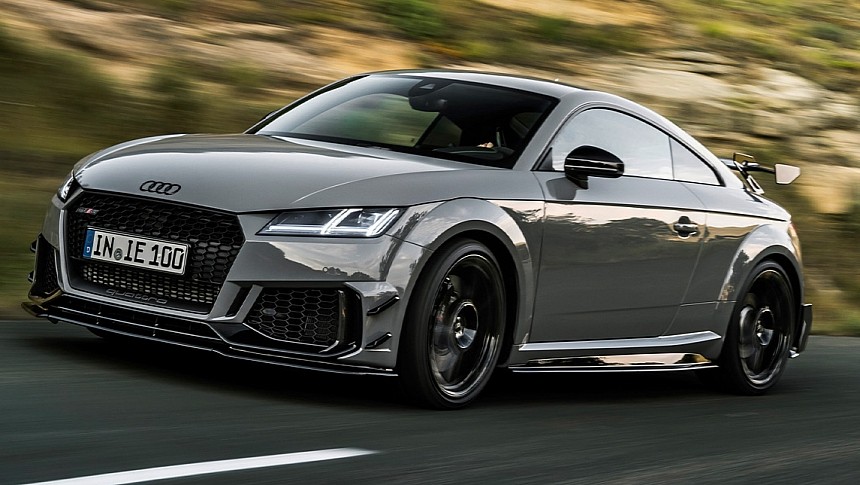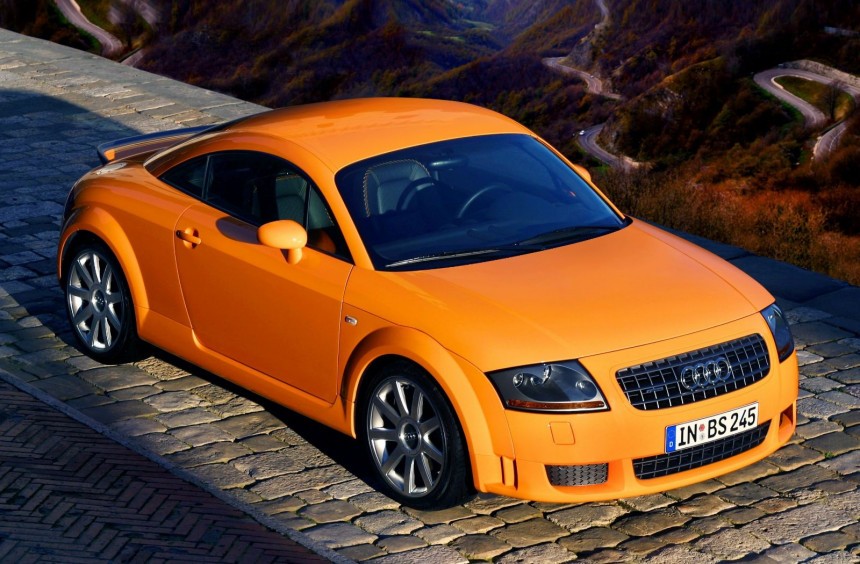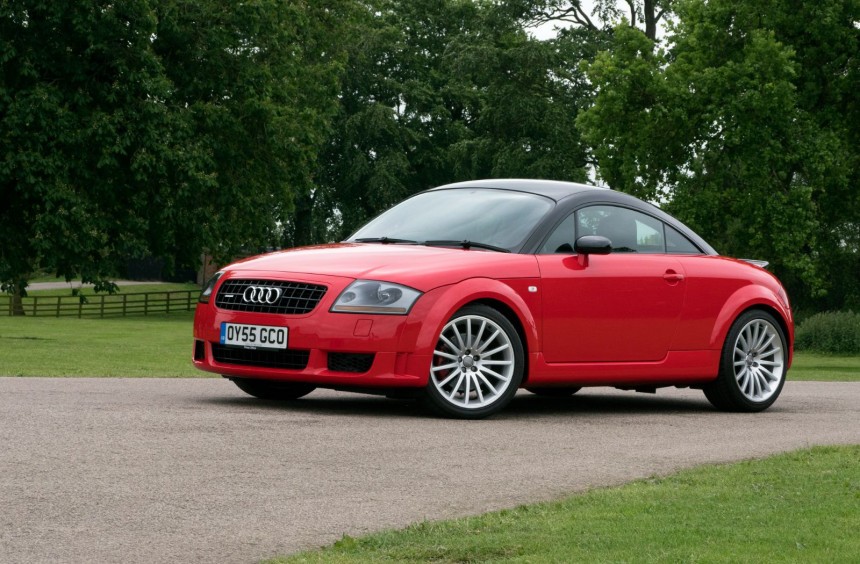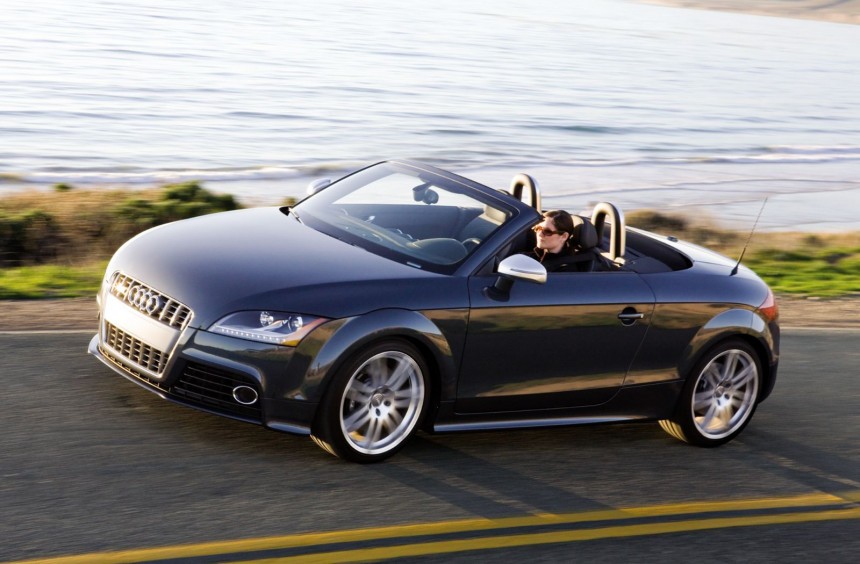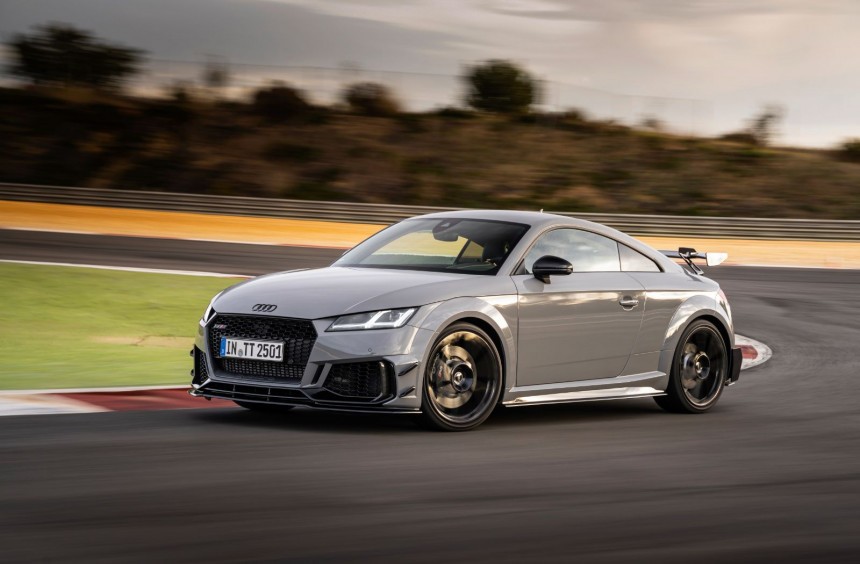Audi's small sports car is celebrating its 25th and, unfortunately, last year of production. To mark the occasion, let's remember five of its most impressive editions.
The Audi TT story started at the 1995 Frankfurt Motor Show when the first concept car was unveiled.
In many ways similar to the later production version, the concept was designed by German-American stylist Freeman Thomas at the VW Group's Design Centre in California.
Its name came from the British Isle of Man TT (Tourist Trophy) motorcycle race where German manufacturer (of both bikes and cars) NSU Motorenwerke was very successful during the 1950s. NSU later merged with Auto Union, forming the Audi brand. Moreover, NSU also produced the Prinz, a line of small two-door sedans, of which the sportier versions were called TT and TTS, in honor of the same motorcycle race.
The Audi TT entered production in October 1998 using the Group's A4 platform, which also underpinned the Mk4 VW Golf, the first-gen Audi A3 and several other VW Group models.
Created to rival compact sports cars from Japan, the TT was initially powered by a somewhat lazy turbocharged inline-four, but over the next 25 years, Audi introduced these five rabid editions that made the model iconic.
For the first four years, the TT coupe or convertible (roadster) versions were powered by the VW Group's potent 1.8-liter turbocharged DOHC inline-four that could be had in one of two output versions. The first was rated at 178 hp and 173 lb-ft (235 Nm) of torque, while the second made 222 hp and 207 lb-ft (280 Nm) of twist. Both were available with a conventional FWD system or the novel Haldex Traction AWD system rebranded quattro.
These versions were more than adequate, but the TT made its first step to becoming a genuine high-performance sports car when the 3.2 quattro version was introduced in early-2003.
Except for the addition of slightly more aggressive bumpers, it looked very similar to the other available TTs, but under the hood, it hid VW Group's legendary VR6 engine. A naturally-aspirated six-cylinder, it initially delivered 247 hp of smooth power and 236 lb-ft (320 Nm) of torque to all four wheels thanks to the quattro system.
The 3.2 Quattro also had a sportier interior, a revamped suspension, and a new dual-clutch Direct-Shift Gearbox (DSG) that improved acceleration. Still, those who preferred a manual could choose the standard six-speed.
This sporty version returned in 2006 as part of the redesigned second-generation (8J) range. Since the VW Group started marketing its VR6 engine as a V6, the second-gen edition is often called 3.2 V6 quattro. The engine was improved for better fuel economy and cleaner emissions, but the output ratings remained unchanged.
Though the 3.2 Quattro was the top performer of the first generation, many TT enthusiasts preferred the smaller turbocharged 1.8-liter. However, Audi was set to discontinue the engine for the upcoming second generation, which debuted in 2006.
To give the trusty four-cylinder a proper send-off and appease its fans, the carmaker launched a special edition coupe dubbed quattro Sport (or Club Sport in Germany) in 2005.
Compared to other versions, the quattro Sport featured a unique two-tone paint finish, bespoke wheels, and motorsport-style Alcantara-trimmed front bucket seats. It came with the same bumpers as the 3.2 Quattro but was 165 pounds (75 kg) lighter.
Its 1.8-liter made ten fewer horses (237 hp) than the VR6 and the same amount of torque, but with less weight, the quattro Sport could sprint to 62 mph (100 kph) in 5.9 seconds - nearly half of a second quicker than the 3.2 (6.3 seconds).
The second-generation TT was not only better-looking and more technologically advanced than the first but also a lot more powerful thanks to the new range of FSI and TFSI inline-fours. Moreover, the range welcomed the much-anticipated addition of the S and RS Audi Sport-engineered versions.
The TTS was presented to the public at the 2008 North American International Auto Show (NAIAS) in Detroit.
Available in both coupe or convertible guises, it came with visual upgrades like more aggressive bumpers and side skirts, unique wheels, a sportier suspension setup, standard quattro, better brakes, and a twin-pipe, dual-exiting exhaust.
Its engine was based on the standard TT's 2.0 TFSI inline-four but with many improvements that bumped the output to 268 hp and 258 lb-ft (350 Nm) of torque. The unit was mated to either a close-ratio six-speed manual or a six-speed S tronic DSG automatic (the only choice for the US model).
The TTS returned with the same modifications for the third and final generation. It continued to use the beefed-up 2.0 TFSI, albeit with a power increase to 306 hp and 280 lb-ft (380 Nm) of torque.
Since the introduction of the RS 2 Avant (co-developed with Porsche) in 1994, the RS badge became synonymous with Audi's most rabid high-performance models.
Though the A4 and A6 ranges got an RS model in 1999 and 2002, TT enthusiasts had to wait until 2009 to get one.
Like the TTS, the RS version received unique visual upgrades, but they were far more aggressive. It also received a standard fixed rear spoiler or an optional retractable version, both unique to this model.
Mechanically, the TT RS rode on the same lowered and stiffened suspension system as the S (with the Magnetic Ride system being optional) but received larger brakes with two-piece cross-drilled front discs. It also came with the Haldex-based quattro system as standard.
Undoubtedly the most impressive upgrade was the all-new 2.5-liter DOHC inline-five turbocharged engine that made 335 hp and 332 lb-ft (450 Nm) of torque.
Three years after the initial TT RS was launched, Audi added an even more powerful version dubbed RS plus. It featured the same engine, but its output increased to 355 hp and 343 lb-ft (465 Nm) of torque.
In 2016, the third-generation TT RS came with even more power. Using the same straight-five engine, it made 394 hp and 354 lb-ft (480 Nm) of torque.
Recently, the German manufacturer announced that it would increase its focus on electrification, steadily dropping its ICE-powered models, and among the first to get axed is the TT.
To celebrate 25 years of the now-iconic model line, the Germans launched a very special version of the RS, fittingly called TT RS Iconic Edition.
Available only as a coupe, the Iconic Edition is based on the standard third-gen TT RS, but it stands out visually thanks to its aggressive, motorsport-inspired aero kit.
Unfortunately, Audi failed to also upgrade the engine, which is a standard TT RS unit rated at 394 hp and 354 lb-ft (480 Nm) of torque.
Nevertheless, this special edition will go down as the rarest, meanest-looking, and most powerful production TT. Speaking of which, only 100 units will be built, including 11 RHD versions, and only European buyers have the privilege of buying one.
In many ways similar to the later production version, the concept was designed by German-American stylist Freeman Thomas at the VW Group's Design Centre in California.
Its name came from the British Isle of Man TT (Tourist Trophy) motorcycle race where German manufacturer (of both bikes and cars) NSU Motorenwerke was very successful during the 1950s. NSU later merged with Auto Union, forming the Audi brand. Moreover, NSU also produced the Prinz, a line of small two-door sedans, of which the sportier versions were called TT and TTS, in honor of the same motorcycle race.
The Audi TT entered production in October 1998 using the Group's A4 platform, which also underpinned the Mk4 VW Golf, the first-gen Audi A3 and several other VW Group models.
Created to rival compact sports cars from Japan, the TT was initially powered by a somewhat lazy turbocharged inline-four, but over the next 25 years, Audi introduced these five rabid editions that made the model iconic.
Audi TT 3.2 quattro
These versions were more than adequate, but the TT made its first step to becoming a genuine high-performance sports car when the 3.2 quattro version was introduced in early-2003.
Except for the addition of slightly more aggressive bumpers, it looked very similar to the other available TTs, but under the hood, it hid VW Group's legendary VR6 engine. A naturally-aspirated six-cylinder, it initially delivered 247 hp of smooth power and 236 lb-ft (320 Nm) of torque to all four wheels thanks to the quattro system.
The 3.2 Quattro also had a sportier interior, a revamped suspension, and a new dual-clutch Direct-Shift Gearbox (DSG) that improved acceleration. Still, those who preferred a manual could choose the standard six-speed.
This sporty version returned in 2006 as part of the redesigned second-generation (8J) range. Since the VW Group started marketing its VR6 engine as a V6, the second-gen edition is often called 3.2 V6 quattro. The engine was improved for better fuel economy and cleaner emissions, but the output ratings remained unchanged.
Audi TT quattro Sport (Club Sport)
To give the trusty four-cylinder a proper send-off and appease its fans, the carmaker launched a special edition coupe dubbed quattro Sport (or Club Sport in Germany) in 2005.
Compared to other versions, the quattro Sport featured a unique two-tone paint finish, bespoke wheels, and motorsport-style Alcantara-trimmed front bucket seats. It came with the same bumpers as the 3.2 Quattro but was 165 pounds (75 kg) lighter.
Its 1.8-liter made ten fewer horses (237 hp) than the VR6 and the same amount of torque, but with less weight, the quattro Sport could sprint to 62 mph (100 kph) in 5.9 seconds - nearly half of a second quicker than the 3.2 (6.3 seconds).
Audi TTS
The TTS was presented to the public at the 2008 North American International Auto Show (NAIAS) in Detroit.
Available in both coupe or convertible guises, it came with visual upgrades like more aggressive bumpers and side skirts, unique wheels, a sportier suspension setup, standard quattro, better brakes, and a twin-pipe, dual-exiting exhaust.
Its engine was based on the standard TT's 2.0 TFSI inline-four but with many improvements that bumped the output to 268 hp and 258 lb-ft (350 Nm) of torque. The unit was mated to either a close-ratio six-speed manual or a six-speed S tronic DSG automatic (the only choice for the US model).
The TTS returned with the same modifications for the third and final generation. It continued to use the beefed-up 2.0 TFSI, albeit with a power increase to 306 hp and 280 lb-ft (380 Nm) of torque.
Audi TT RS
Though the A4 and A6 ranges got an RS model in 1999 and 2002, TT enthusiasts had to wait until 2009 to get one.
Like the TTS, the RS version received unique visual upgrades, but they were far more aggressive. It also received a standard fixed rear spoiler or an optional retractable version, both unique to this model.
Mechanically, the TT RS rode on the same lowered and stiffened suspension system as the S (with the Magnetic Ride system being optional) but received larger brakes with two-piece cross-drilled front discs. It also came with the Haldex-based quattro system as standard.
Undoubtedly the most impressive upgrade was the all-new 2.5-liter DOHC inline-five turbocharged engine that made 335 hp and 332 lb-ft (450 Nm) of torque.
Three years after the initial TT RS was launched, Audi added an even more powerful version dubbed RS plus. It featured the same engine, but its output increased to 355 hp and 343 lb-ft (465 Nm) of torque.
In 2016, the third-generation TT RS came with even more power. Using the same straight-five engine, it made 394 hp and 354 lb-ft (480 Nm) of torque.
Audi TT RS Iconic Edition
To celebrate 25 years of the now-iconic model line, the Germans launched a very special version of the RS, fittingly called TT RS Iconic Edition.
Available only as a coupe, the Iconic Edition is based on the standard third-gen TT RS, but it stands out visually thanks to its aggressive, motorsport-inspired aero kit.
Unfortunately, Audi failed to also upgrade the engine, which is a standard TT RS unit rated at 394 hp and 354 lb-ft (480 Nm) of torque.
Nevertheless, this special edition will go down as the rarest, meanest-looking, and most powerful production TT. Speaking of which, only 100 units will be built, including 11 RHD versions, and only European buyers have the privilege of buying one.
